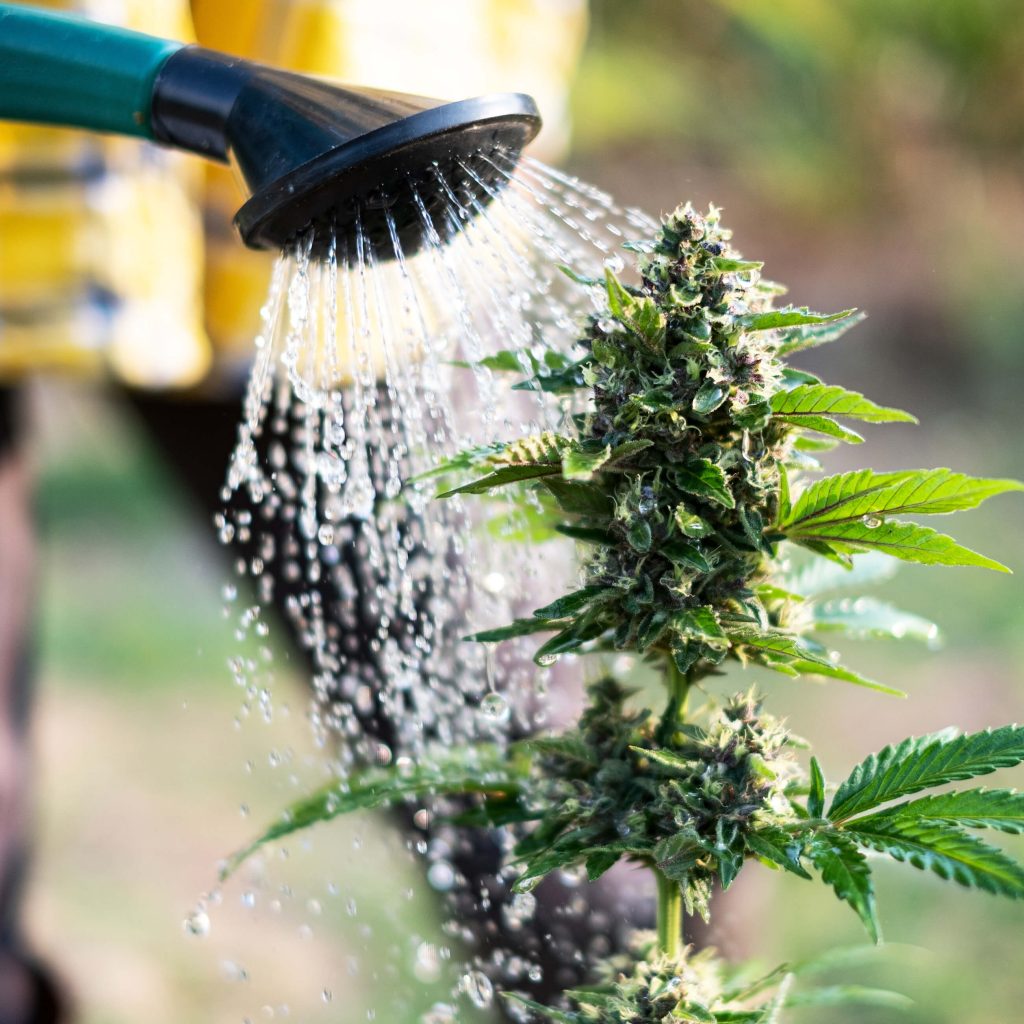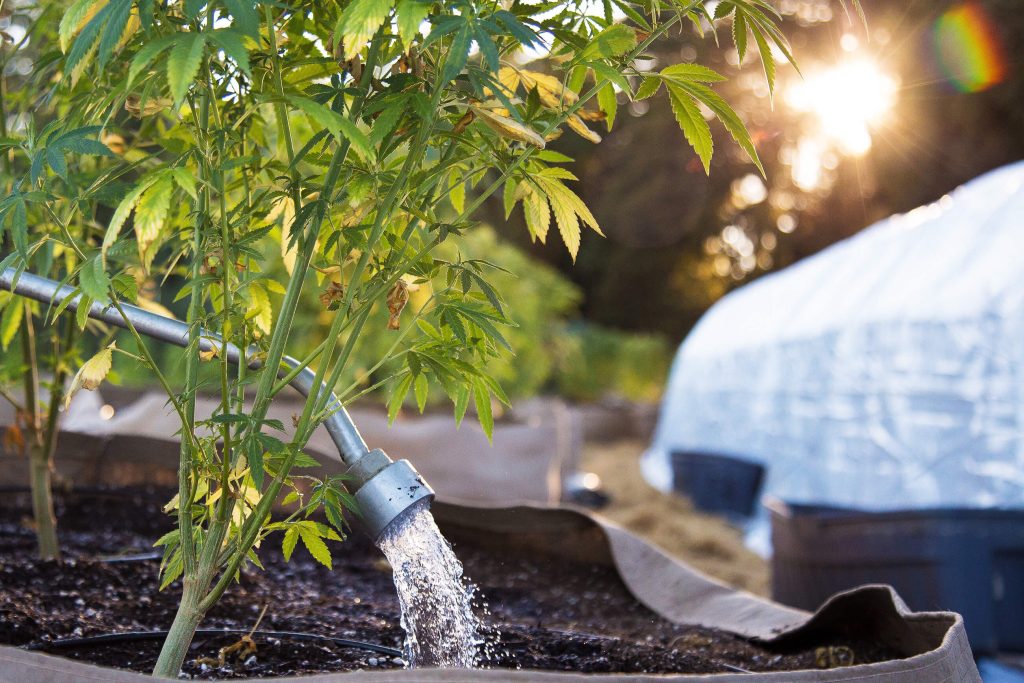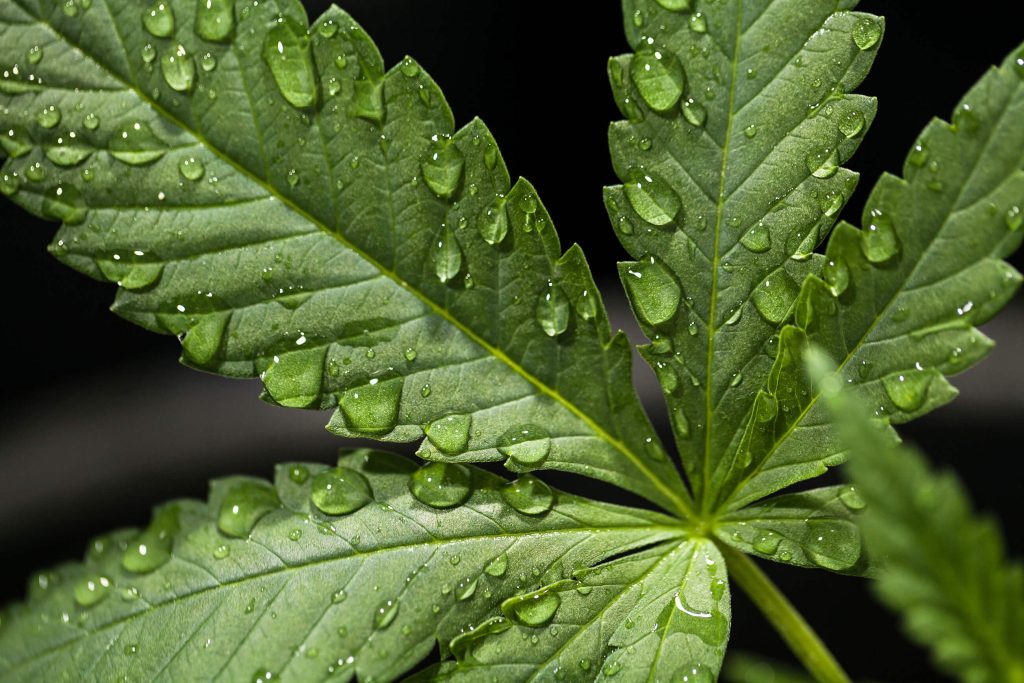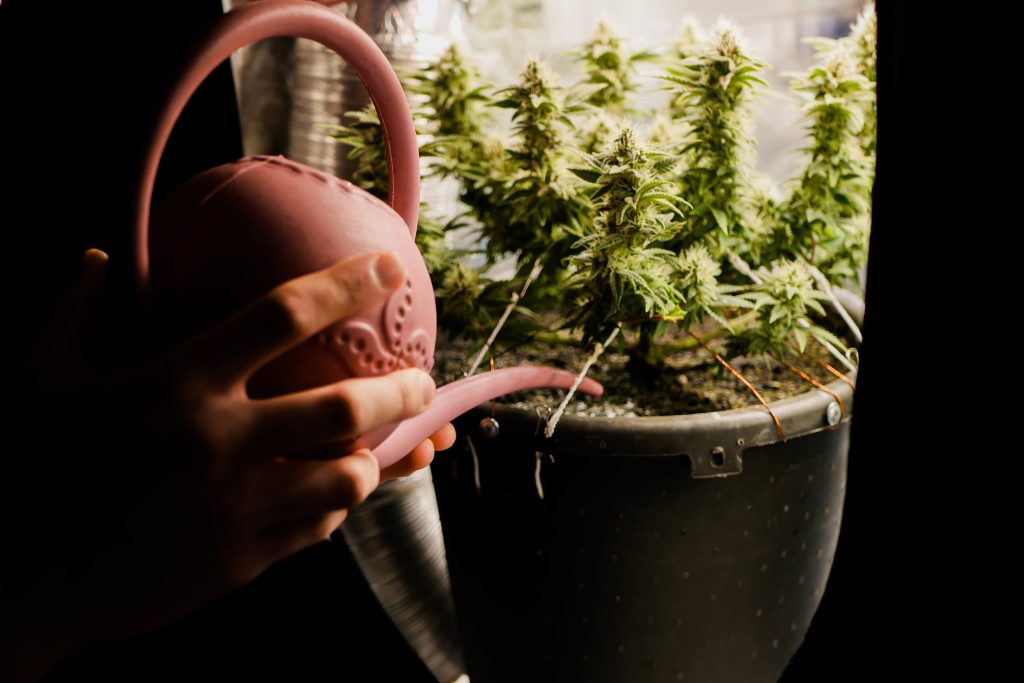To eliminate excess salts and enhance the smoking experience, it is recommended to flush cannabis plants with plain water. We explain flushing for different growing mediums, how to optimise your watering practices, and more. Whether you are a beginner or an experienced grower, this guide provides essential information about flushing your cannabis plants.
What does flushing mean?
Flushing cannabis has become a common practice during the final stages of a cannabis plant’s life cycle. When plants grow in soil, coco, or a hydroponic growing medium, providing water without nutrients during the last 7 to 14 days has many benefits. Flushing is essential to the growing process from legally licensed cultivation facilities to hobby growers!


Many believe that flushing your plants will not only wash away any undissolved salts that have accumulated inside the growing medium around the root zone but also cause weed plants to enter a catabolic state. In other words, they begin to feed on themselves, which gives the impression that the plants are using any internal reserve nutrition before being harvested.
When is the right time to flush weed plants?


The optimal length of the flushing period is a subject of debate among many growers. While most prefer a 14-day period before harvest, some find that a seven-day period of plain water is sufficient. Notably, the flushing period should coincide with the strain’s flowering time. For instance, if a grower is flowering a strain with an expected flowering time of 8 weeks, the flush will occur between weeks 6 and 8 of the flowering stage to ensure optimal results.
After flushing, growers can enjoy a smoother smoke and improved flavour and aroma in their final product.
The benefits of flushing


There are many benefits associated with flushing cannabis plants. The flavour of weed will taste much smoother and more refined, and the ember of a joint will burn slowly without side burning. The ash from a joint will also be soft white and fall at the lightest tap. As far as practicality goes, substrates such as coco and soil can be reused once well flushed, and medicinal users prefer the peace of mind of a product free of chemicals and salts.
What are the salts that need flushing out?
As you may be aware, cannabis plants need a balance of primary and secondary nutrients, as well as trace mineral elements, to grow strong and healthy. These essential nutrients come in salts, which dissolve in contact with water. However, over time, these salts can build up around the roots and sit within the growing medium, potentially causing harm to your plants. Therefore, it is crucial to understand the risks of nutrient buildup and take appropriate measures to flush your plants correctly.


Primary nutrients
Primary nutrients, or micronutrients, are essential elements that plants require in relatively large quantities for their growth and development. There are three primary nutrients:
1. Nitrogen (N)
Nitrogen is a key component for chlorophyll production, allowing weed plants to photosynthesise and store energy. Cannabis plants will use nitrogen during the seedling, vegetative and flowering stages.
2. Phosphorus (P)
Phosphorus is a nutrient that helps boost root growth and is responsible for flower production. This nutrient is essential during the early growth stages of weed plants and clones.
3. Potassium (K)
Potassium combined with phosphorus will promote a heavy set of flowers and buds. It is also responsible for the stomata function of the leaf tissue, which allows plants to absorb CO2 and perform photosynthesis.
Secondary nutrients
The plants use these nutrients less than the primary nutrients mentioned above; however, they are just as important in their own unique way. There are three secondary nutrients weed plants require during their lifecycle.
1. Calcium (Ca)
Calcium is an essential nutrient which helps plants fight off disease and pests. A key component for building cell walls, often sold together with magnesium as Cal-Mag.
2. Magnesium (Mg)
Magnesium has many roles and functions as a secondary plant nutrient, ranging from chlorophyll synthesis to enzyme activation.
3. Sulphur (S)
Sulphur is responsible for enzyme activity and nitrogen, oil and protein synthesis metabolism.
Trace elements
As the title suggests, these elements are present in trace amounts. Trace elements are responsible for photosynthesis, hormone production, cell development, flower and seed production. So, let us check out the six most important elements.
1. Manganese (Mn)
Manganese is essential for plant growth, production, metabolism, and interaction with plant cells.
2. Copper (Cu)
Copper is responsible for enzyme production, chlorophyll development and germination.
3. Zinc (Zn)
Zinc has a role which aids enzyme production and plant metabolism and is a key player with general plant health.
4. Iron (Fe)
Iron aids with chlorophyll production and photosynthesis, fruit and flower production. Too much iron can cause plants to become stunted.
5. Boron (B)
The role of boron is to help with root elongation and tissue production, cell membranes and pollen production.
6. Molybdenum (Mo)
Molybdenum is responsible for the synthesis and activity of enzymes and is vital for the process of nitrogen. It will then convert nitrogen to amino acids and fix nitrogen in the soil.
Step-by-step guide to flushing


As a responsible grower, it is crucial to understand the importance of flushing your cannabis plants to remove excess nutrients and salts that can build up in your medium. This process helps to ensure that your plants reach their full potential in terms of flavour, aroma, and overall quality. Luckily, we have a comprehensive step-by-step guide that will help you flush your cannabis plants correctly and effectively.
1. The water source
To ensure proper flushing of cannabis, it is imperative to utilise a fresh water source. This can be attained from various sources, such as bottled water, tap water, or rainwater. It is, however, crucial to avoid using stagnant water, as it can harm plants. It is worth noting that soft water, which has lower levels of calcium and magnesium, is preferable for flushing cannabis compared to hard water.
Reverse osmosis water is also an excellent choice for flushing. This purified water is produced by filtering regular tap water through a specialised membrane filter that functions as a super-fine sieve. It allows only water molecules to pass through while blocking impurities and contaminants. If you have access to reverse osmosis water, it can be a valuable asset in achieving optimal plant growth.
2. Check the pH level
Depending on which growing medium is being used will determine the pH level of the water the plants will receive from seed until harvest. The best way to check the pH of your water source is by using a digital pen. Below is more detailed information about the recommended Ph levels for soil, coco and rock wool.
3. Water temperature
The ideal water temperature for cannabis plants is between 18 and 22°C (64 to 71°F). Avoid providing weed plants with cold water, as this will cause the temperature of the root zone to drop significantly and can potentially hinder the plant’s development.
4. The flush
During the flushing process, it is recommended to water your plant pot using three to five times the volume of water typically used. Pour water around the base of the stem and wait for the water to permeate through the soil. This process will help to ensure that the growing medium becomes thoroughly soaked, with excess water draining from the bottom.
5. Disposing of run-off water
Disposing the run-off water is crucial, as it contains all the unwanted residues removed from your growing medium. Always remember that proper flush measures can prevent nutrient buildup and help your plants reach their full potential.
Flushing plants in coco
Coco coir is made from the hairs of coconut husks. Once treated with salts and buffered, coco becomes an excellent growing medium thanks to its high water content and air capacity. It is best to use reverse osmosis water at pH 6.0 when flushing weed plants grown with coco. Adding enzymes to used coco will also break down old root matter, allowing it to be recycled and used for a second crop.
How to flush plants in soil
Flushing cannabis plants grown in living soil will probably cause the most considerable debate among growers regarding flushing. Organic nutrients will buffer over 72 hours, digested by the beneficial microbes and bacteria in the soil. Some soil growers may only feed plain water throughout the entire life cycle and may not even need to wash away salt buildup. The pH of the water should be between 5.5 and 6.5 for an organic soil substrate.
How to flush plants in rock wool
Rock wool is a hydroponic growing medium containing no nutrients, making it an inert growing medium perfect for hydroponic applications. With the ability to hold up to 18 times its weight in water, rock wool is used for commercial-scale vegetable and fruit production. It is the most popular among indoor hydroponic growers. The pH of the water should be between 5.5 and 6.5 when flushing weed plants in rock wool. Unlike coco, rock wool cannot be recycled and should be discarded after every harvest.
How to flush cannabis autoflowering varieties
Autoflower cannabis plants can be treated the same way as photoperiod plants. Fourteen days will be the ideal time to feed autoflowering plants in plain water. So if you are new to growing autoflowering plants, follow our guide and give your plants the best possible chance to thrive! This will help you avoid common mistakes and ensure your plants receive the proper care they need throughout their growth cycle.
Nutrient lockout in cannabis plants


Nutrient lockout occurs when cannabis plants can’t absorb nutrients from their growing medium, often due to a pH imbalance or excessive nutrient buildup, especially salts from fertilisers.
- Causes: Imbalanced pH and overfertilisation leading to nutrient and salt accumulation.
- Symptoms: Stunted growth, leaf discolouration, and poor bud development, resembling nutrient deficiencies.
- Management: Prevent and address lockout by regularly flushing the growing medium with pH-balanced water to remove excess salts and minerals. Monitoring pH and electrical conductivity (EC) levels helps in early detection and maintaining a balanced feeding schedule is crucial to avoid overfertilisation.
Flushing not only prevents nutrient lockout but also can resolve it if symptoms appear, maintaining the health of cannabis plants.
Constant vs active flushing
Constant flushing is a technique used in cannabis cultivation where plants are watered exclusively with plain water throughout the flowering stage. While this approach assumes that the nutrients in the growing medium are enough to support the plant’s growth, it may result in nutrient deficiencies if essential nutrients are absent.
On the other hand, active flushing is a targeted approach that involves supplementing cannabis plants with only water during the final weeks of flowering. This method helps to optimise the removal of residual nutrients and reduce the risk of nutrient deficiencies during the bulk of the flowering stage. However, it does require careful monitoring and may involve more labour-intensive management than constant flushing.
Tips to consider for flushing weed
Flushing weed not only improves the smoking experience it also gives you an indication of how far your plants are ready for harvest day. Below are three top tips to consider to help you get the most out of the flushing period.
1. Using enzymes to flush cannabis plants
Enzymes are not only protein building blocks for weed plants, but they also accelerate the decomposition of undissolved salts. An excellent tip is to try at least two different enzyme products. The more enzymes a grower can provide for the substrate and roots, the more your plants will thank them.
Enzymes are building blocks for proteins and actively break down organic matter. There are many benefits for growers who use enzymes not only during the flushing period but also throughout the seedling, vegetative, and flowering periods. Roots love a good enzyme wash and will produce a bright, healthy glow.
2. Identifying the harvest window
The day a grower decides to harvest their cannabis plants should be based not only on how many days are left to flush but also on trichome maturity, calyx development, trichome coverage, and terpene production. Aligning the flushing stage with the above traits will allow them to achieve the most significant yields possible.
Fourteen days is the most popular choice amongst growers; however, some find seven days of plain water work just fine. The flushing period should coincide with the strain’s flowering time. So, for example, if a grower is growing a strain with an expected flowering time of 8 weeks, the flush will occur after 6 to 8 weeks of flowering.
3. Optimal watering practices for healthy growth
Root rot occurs when the growing medium becomes too wet, and the oxygen levels around the roots become too low. As a result, aerobic bacteria infect the roots, leading to a world of problems. The best way to prevent root rot is to allow the growing medium to dry out again. Dry-back periods are the way to solve overwatered substrates.
The flushing weed myth debunked


In 2020, RX Green Technologies conducted an in-house study to determine whether flushing plants affect cannabinoid production, yield, mineral content, and extract quality. Using a Cherry Diesel plant, the study involved flushing samples for zero days, one week, ten days, and 14 days.
The results showed a slight increase in THC levels and terpenes in the flushed samples, with no significant difference in mineral content. Interestingly, the 14-day flushed sample had the highest return on extracts, and the blind taste test resulted in an even score across the board, indicating no significant difference in taste.
At Sensi Seeds, we consider flushing to be a crucial and integral step in the growing process. By flushing the plants with plain water before the harvest, we can effectively remove any excess nutrients and salts from the plant’s system. This process helps to improve the overall quality of the final product, resulting in a smoother smoke and better flavour and aroma. Whenever we grow plants in our facilities for the purpose of creating a grow report, we apply flushing during the final grow stage as well.
Is flushing my weed plants essential?
Growers can debate for hours which flushing technique works best if one week or two is the way forward, and some believe flushing is not even necessary in the first place. However, after reading this article, you should be more than confident in understanding the importance of flushing weed means.
Flushing methods can vary among growers, so remain open-minded and choose what works best based on your skills and experience. Good luck mastering the flush game and growing the best crop possible!
-
Disclaimer:Laws and regulations regarding cannabis cultivation differ from country to country. Sensi Seeds therefore strongly advises you to check your local laws and regulations. Do not act in conflict with the law.
- SEO Powered Content & PR Distribution. Get Amplified Today.
- PlatoData.Network Vertical Generative Ai. Empower Yourself. Access Here.
- PlatoAiStream. Web3 Intelligence. Knowledge Amplified. Access Here.
- PlatoESG. Carbon, CleanTech, Energy, Environment, Solar, Waste Management. Access Here.
- PlatoHealth. Biotech and Clinical Trials Intelligence. Access Here.
- Source: https://sensiseeds.com/en/blog/flushing-cannabis-plants-guide-for-optimal-yield-and-aromas/



